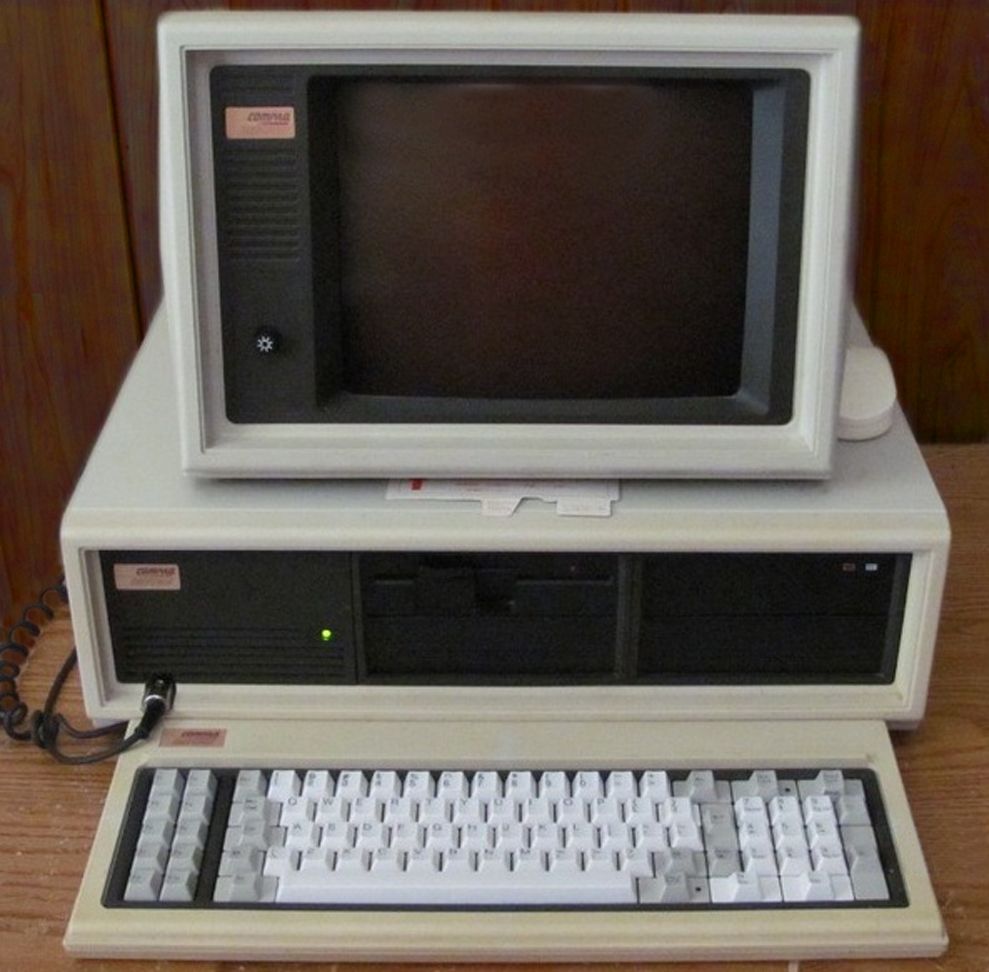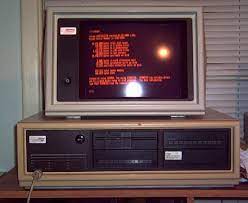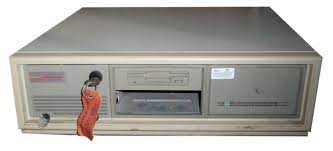| Compaq Computer Corporation started in Houston Texas at the "House of Pies" when 3 ex-Texas Instruments engineers, Rod Canion, Bill Muerto, and Steve Harris (no, not Iron Maiden's bass player) got together to come up with their own idea of an IBM COmpatible portable computer - after deciding starting a Mexican resturant was too risky of a business. The machine was sketched down on a pie plate and eventually realized as the 1982 Compaq Portable PC. The Compaq Portable and it's uncompromising standard of quality made Compaq one of IBM's biggest contenders, and the Portable Series would continue with the Portable Plus, Portable II, Portable 286, Portable III, Portable 386, and the Portable 486 series ending in 1993 with the Portable 486C/66. The portable series were "luggable" and "lunchbox" style workstations intended to be carried to the work site and then treated like a regular desktop.
But in 1984, Compaq's other unsung hero was released, their desktop computer - the Compaq Deskpro. The original Deskpro was an intel 8086 (not 8088) powered PC/XT class workstation with 4x external half-height bays, Turbo, and very high benchmarks to go with it. The Compaq DSM Monochrome monitor was mated to various CGA/EGA cards and could do graphics and text mode - unlike IBM's MDA.
The original Deskpro spawned a series of computers including the Deskpro 286 (1985), and the groundbreaking Deskpro 386 (1986) which beat IBM's initial 386 release by a whole 9 months. The Deskpro 386 was so successful it spawned a even longer running line of 386 machines - which is where our saga stops (for now) with the 386s (386SX) and 386e (Enhanced) machines that used a newer, "slimline" design, signifying the end of Compaq's quality, but just missing the beginning of their decline.
Compaq Deskpro/286/386 versions
The original Compaq Deskpro was a high end workstation intended for serious work, they are also seriously rather cool machines (and I like the design language used on them). There were MANY Versions, however, made by Compaq over the years. Here's a pictorial listing.
| PICTURE
| SPECS
| DESCRIPTION
|
Deskpro
Model#1/2/3/4

| - Intel 8086 @ 7.16/4.77MHz
- 128K-768K RAM
- Single 360K DSDD 5.25" Floppy Drives
- CGA Compatible Graphics Card
- Compaq DSM Monochrome 13" 12VDC proprietary monitor
- 84 Key Compaq Keyboard
- MS-DOS 2.1
| The original Compaq Deskpro was released in 1984 and came in 4 configurations with various numbers of floppy and MFM/RLL Hard Disk Drives. I believe the 20MB models (HDD) had a full height drive and dual floppies. Most of these seemed to ship with the 12V Compaq DSM MOnochrome Monitor, which was a graphics capable, Amber Phosphor (though green have been seen), monitor that got it's power from a DIN jack on the back of the computer next to the ISA slots that provided high-current 12VDC power to the monitor, making the monitor ONLY compatible with Compaq computers, and no others. The Keyboard used foam-pad keys just like the original Portable, which means most examples you'll find in the wild will have a dead keyboard. You can get replacement pads from TexElec. The case was made by Parkview Metals in texas and while it looks like a standard AT form factor design, it's actually not. The Deskpro "original" design uses a Baby-AT sized motherboard (about 8.5"x11") with eight 8-bit ISA slots. The power supply just has one big ribbon cable coming out of it feeding 4 plugs on the motherboard that get their own removable cables for drives (up to 4). The keyboard jack is on the lower front - a standard XT compatible 5 pin DIN - but it connects to the motherboard in the front via a pin header. Power for the screen is also taken from the Motherboard as well. Drives were mounted on 5"x1" aluminum drive rails that secured from one side with regular floppy drive screws. The rest of the computer was put together with the ubiqutous Compaq-Style flat-head + T-15 torx screws, including ISA cards.
|
Deskpro 286
Model# 2551

| - Intel or AMD 80286 @12MHz
- 256K-10MB RAM
- Choice of One or two 5.25" disk Drives in either 360K DSDD or 1.2MB HD
- Choice of MFM/RLL HDDs in capacities of 20MB to 60MB (ESDI possibly an option later)
- CGA/EGA Compatible Graphics Card
- Compaq DSM Monochrome 13" 12VDC proprietary monitor, or 15" Compaq EGA Compatible Display
- 101 Key Compaq Keyboard
- MS-DOS 3.x
| The Deskpro 286 came just a year later and was Compaq's competitor to the IBM PC AT 5170. The earliest machines still used that 12V proprietary power CGA compatible Amber DSM Monochrome CRT. Also following the AT was the change to a regular 101 Key IBM Model "M" style layout keyboard a little later on. The Deskpro 286 changed the case design a little as well, omitting the power LED used on the previous computer to tell you when it was in turbo and PC Compatible modes, replacing it with a large, black keylock that actually physically locks the case and provides and early form of intrusion detection with a switch. It seems the 2551 carried on for quite awhile, running from 1985 to 1990 when Compaq change to slimline, even including some late-era "Greyface" variants where the dark brown bezel surrounding the drives was changed to a lighter gray color.
|
Deskpro 386
Model# 2571

| - Intel 386 DX-16Mhz
- 1MB-16MB of RAM
- Dual 360K DSDD 5.25" Floppy Drives, 720K and 1.44M 3.5" Options came later and aftermarket
- 20/40/60/80/120MB early-IDE Control Data Corporation Hard Disks (type sticker on the drive's face)
- Quadram EGA Graphics Card, later VGA Graphics Optional
- Compaq DSM Monochrome 13" 12VDC proprietary monitor, Compaq 14" EGA Compatible Monitor, Compaq 14" VGA Compatible Monitor
- 101 Key Compaq Keyboard
- MS-DOS 3.31
| The myth, the legend, the original Compaq Deskpro 386! It beat out IBM's first 386 release, the IBM PS/2 Model 80, by a full NINE MONTHS. This was a tremendous deal and was one of the things that broke the old saying "nobody got fired for buying IBM". This made it the fastest IBM Compatible PC on the market at the time. The original deskpro 386 still used a small rectangle logo in the old style, with the beige case framing a dark brown bezel. But inside the machine had some changes including the move to early IDE HDDs and later even 1.44MB 3.5" Floppy Drives (Black), and even a Tape Backup Unit Option (kinda' rare, seen on the 20MHz example below). These continued to be produced up until 1989-1990 along side the 286, and the 20 and 25MHz models, so there could be some later "Grey Face" versions. These were also offered with a Compaq EGA and Compaq VGA monitors later on.
|
Deskpro 386/20
Model# 257x

| - Intel 386 DX-20Mhz
- 1MB-16MB of RAM
- Dual 360K DSDD 5.25" Floppy Drives, 720K and 1.44M 3.5" Options came later and aftermarket
- Quadram EGA Graphics Card, later VGA Graphics Optional
- Compaq DSM Monochrome 13" 12VDC proprietary monitor, Compaq 14" EGA Compatible Monitor, Compaq 14" VGA Compatible Monitor
- 101 Key Compaq Keyboard
- MS-DOS 3.31
| The Deskpro 386/20 comes in 2, possibly 3 variants. There's the earliest ones which have the Deskpro 386 older style, rounded, rectangle badge, and then there's a later version with a larger badge and the later updated logo. There's also a slight possibily this 20MHz variant came in a "Greyface" version just like other models from the 286 onward. The only real big difference between this and the earlier models is the processor speed, and it seems they sold slightly less than the original 16Mhz Deskpro 386.
|
Deskpro 386/25
Model# 257x

| - Intel 386 DX-25Mhz
- 1MB-16MB of RAM
- Dual 360K DSDD 5.25" Floppy Drives, 720K and 1.44M 3.5" Options came later and aftermarket
- Quadram EGA Graphics Card, later VGA Graphics Optional
- Compaq DSM Monochrome 13" 12VDC proprietary monitor, Compaq 14" EGA Compatible Monitor, Compaq 14" VGA Compatible Monitor
- 101 Key Compaq Keyboard
- MS-DOS 3.31
| The Deskpro 386/25 was the last version of the Deskpro series to use the original AT style case design. It seems a lot more of these were produced in the 1988 and later "Grey Face" variant than any other model (with the 2551 deskpro 286 coming 2nd most built in that design). The 386/25 was released a year later with the SLimline version of the Deskpro - the Deskpro/33.
|
Deskpro 386s
Model#2530

| - Intel 386 SX 20MHz
- 1MB-10MB of RAM
- Slimline Floppy Drives available in 3.5" 1.44M and 5.25" 1.2M
- IDE HDD (< 528MB), Connor Peripherals
- Built-In Compaq VGA Compatible graphics
- Compaq 14" VGA Color Monitor
- 101 Key Compaq PS/2 Rubber Dome Enhanced Keyboard II
- MS-DOS 5.00/Windows 3.0/3.1
| The Compaq Deskpro 386s was Compaq's first 386SX based machine. The intel 386 SX was a 16-bit External, 32-bit Internal CPU, similiar to how the Intel 8088 used in the original IBM PC was a 8-bit external, 16-bit internal CPU. These were among some of the first "Slimline" machines. The footprint was reduced by 1/3rd, and the case is a little taller than the original. THis also marked a move to a far more PROPRIETARY design. First off the motherboard was not a standar AT sized board, but rather it's own thing, almost seemingly based on the IBM PS/2 style setup. Many things changed on these. First was tool-less access to the inside via a single flat-head thumbscrew on the top cover in back. The new "slimline" floppy drives and components mounted by sliding into the front and being plugged in via access holes in the removable drive cage. Modular power cables were still a thing as well like the previous models, but now there were 5 ports instead of 4. The new power supply ran down the side like most of IBM's PS/2 70/50 models and featured a power switch on the right front of the case with power and HDD LED lights. The system featured 5 ISA Slots, at least 3 being 16-bit. CMOS battery type changed too from the old Tadiran "brick" style, to a Dallas Clock Chip. Hard Disks were usually Connor Peripherals CP-30xxx series HDDs in capacities from 40MB all the way to 320MB.
|
Deskpro 386s/20
Model#2535

| - Intel 386 SX 20MHz
- 1MB-10MB of RAM
- Slimline Floppy Drives available in 3.5" 1.44M and 5.25" 1.2M
- IDE HDD (< 528MB), Connor Peripherals
- Built-In Compaq VGA Compatible graphics
- Compaq 14" VGA Color Monitor
- 101 Key Compaq PS/2 Rubber Dome Enhanced Keyboard II
- MS-DOS 5.00/Windows 3.0/3.1
| The 386s/20 looked identical to the 386s, but had a few more changes. These included it being one of the first PC's to use 72 pin Memory, with a maximum capacity of 10MB using 4 SIMMS.
|
Drive Slot Layouts
Something interesting about the ORIGINAL design, was that Compaq seemed to be very specific (in the case of the 286 and 386 at least), on where to put the floppy/tape/hard disks in the older style deskpros.
The original Deskpro 8086 usually had 2 floppy drives down the center, and a half-height floppy disk drive or full height drive mounted on the right side bay, with a blanking plate up top. Single drive 8086's usually had the 1.2M drive on top in the left bay with the HDD on the bottom of the right hand bay, and one blanking plate if the HDD was full height, and two if half height.
The most common configuration on the 286 and 386 seen was a single 1.2M Floppy drive in the top of the left bay, and a half-height 5.25" MFM/ESDI/IDE hard disk on the lower right, usually with a large "Type" sticker on it indicating the Compaq BIOS type the drive required (which was often lost after the machine had been in use for awhile).
A fully maxed out Deskpro 386 usually had 2 floppy drives in the top row left and right bays, with a tape drive in the bottom left, and HDD on the bottom right. THis was a similiar setup to what Zenith Data Systems was doing with their own systems at the time.
I know this is strictly cosmetic, but it's just an interesting thing the inner case diagrams on the Deskpro tell you specifically what drives go in what position in the drive cage. Which I might add, has rubber shock absorbers - and likely is a reason a lot of these original Deskpro machines have fully working hard drives 30-40 years onward.
Monitor Options
| PICTURE
| DESCRIPTION/SPECS
|
|


